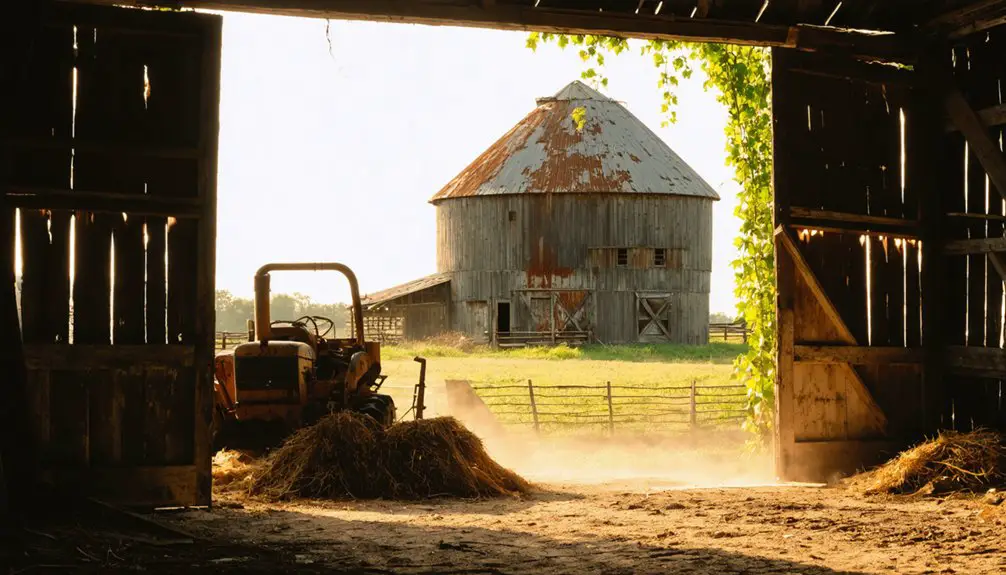You’ll find Childs, Minnesota stands as one of the state’s most historically significant ghost towns. The settlement emerged in the late 1870s as a bustling hub along the Great Northern Railway‘s Wadena to Fergus Falls line, thriving through grain shipments and agricultural commerce. A series of setbacks, including the 1907 fires, 1918 influenza epidemic, and the railway’s eventual closure in 1970, led to its abandonment. The weathered remnants and foundation stones hold fascinating stories of Minnesota’s pioneering spirit.
Key Takeaways
- Childs emerged as a vital rail commerce hub along the Wadena to Fergus Falls line during Minnesota’s railroad expansion in the late 1870s.
- The Great Northern Railway’s decision to bypass Childs, combined with the 1918 influenza epidemic, marked the beginning of the town’s decline.
- Multiple factors contributed to Childs’ abandonment, including devastating fires in 1907, the Great Depression, and highway expansions claiming homes.
- The railroad’s closure in 1970 further isolated the settlement, leading to its eventual status as a ghost town.
- Physical remnants, including foundation stones and weathered buildings, remain as evidence of this vanished frontier community.
The Rise of a Prairie Railroad Town
As railroads expanded across Minnesota in the late 1870s, they fundamentally shaped the development of prairie settlements like Childs by providing essential transportation links between agricultural regions and urban markets.
Town formation along these crucial rail corridors wasn’t random – you’d find carefully planned service nodes featuring grain elevators, stockyards, and depots that supported both the railroad’s operations and local agriculture. The Winona and St. Peter Railroad played a pivotal role in this expansion, reaching westward across southern Minnesota and establishing numerous settlements along its route. Similar to Langdon Village, many railroad towns attracted residents seeking opportunities from surrounding rural areas.
Railroad significance extended beyond mere transportation. You’ll understand how these iron roads dictated settlement patterns across the prairie, with towns sprouting up precisely where the railroads needed them.
Railroads shaped the prairie landscape like puppet masters, strategically placing towns wherever their iron networks required outposts.
Companies like the Northern Pacific and James J. Hill’s enterprises strategically established these communities, creating economic lifelines that connected isolated farming regions to major commercial centers like Minneapolis and St. Paul.
Life During the Golden Years (1888-1920)
During Childs’ prime years, you’d find the Great Northern Railway station bustling with activity as local farmers brought their wheat, corn, and livestock for transport to distant markets. The region experienced a terrifying challenge when the Children’s Blizzard struck in January 1888, testing the resilience of the railway-dependent community.
Your daily routines would’ve revolved around the railway schedule, with the post office serving as the town’s communication lifeline from 1888 to 1920. Like many Minnesota ghost towns that declined after the arrival of rural postal delivery, Childs gradually lost its significance as a central gathering point for the community.
If you were a resident then, you’d have witnessed the rhythmic interplay between railroad commerce and agricultural life, as the station’s presence transformed this farming community into an essential trading hub for the region.
Rail Commerce Hub
While the Northern Pacific Railway expanded across Minnesota in the early 1880s, Childs emerged as an essential rail commerce hub along the strategic Wadena to Fergus Falls line.
You’d find the town bustling with activity as rail infrastructure facilitated the movement of agricultural goods, especially grain shipments, to larger markets. Competing railways, including the Chicago, Milwaukee, and St. Paul, fought for dominance in the region, making Childs a critical link in Minnesota’s transportation network. During this era, the rapid expansion brought Minnesota’s total rail trackage to 5,944.58 miles by 1893.
The town’s strategic location attracted significant investment in terminal elevators and freight facilities, allowing farmers to efficiently move their harvests to major markets. The development was part of a massive 40 million acre land grant program that helped establish vital rail transportation corridors across the region.
As part of the growing northwest transportation empire, Childs played a significant role in connecting rural producers to the expanding rail network that revolutionized commerce across Minnesota.
Daily Farm Life
Beyond the bustling rail commerce of Childs, local farmers carved out a demanding existence through daily routines that shaped life from sunrise to sunset.
You’d find yourself immersed in farm chores without modern conveniences – cutting alfalfa, storing root crops, and tending to livestock needs throughout the changing seasons. The seasonal rhythms dictated your work, from spring planting to winter preparation.
Managing forage crops like alfalfa required multiple cuttings each season, while root crops demanded intensive labor for planting, harvesting, and storage. Families relied on generational farming knowledge passed down through years of working the land. Some farmers followed the example of Ellsworth Childs, who established dairy farming operations that dominated the local milk trade.
You’d spend hours in the fields, building hay reserves and filling root cellars to sustain your livestock through harsh Minnesota winters.
Without electricity or indoor plumbing, you’d rely on manual labor and daylight hours to accomplish essential tasks, working alongside neighbors during critical times like harvest.
The Great Northern Railway’s Influence
The Great Northern Railway’s arrival in Childs transformed the small settlement into a bustling hub, where you’d find farmers delivering grain to the new depot and merchants shipping goods to distant markets.
You’ll notice from historical records that the station’s strategic placement along the line created economic opportunities for both local businesses and regional trade networks throughout the late 1800s. Like many towns across its vast 8,316-mile system, the Great Northern Railway helped establish vital transportation connections from Minnesota to the Pacific Coast.
The railway’s eventual decision to bypass Childs in favor of more profitable routes marked the beginning of the town’s decline, as you can see from the abandoned rail bed that once carried the crucial transportation lifeline. Similar to other towns along the route, Childs had initially benefited from the railway’s practice of promoting European settlement through its network of overseas agencies.
Station’s Economic Impact
As Great Northern Railway established its presence in Childs, Minnesota, the station emerged as a significant economic engine that transformed the region’s agricultural and commercial landscape.
You’d have witnessed remarkable economic synergy as the station became an essential hub connecting local farmers to distant markets, with competitive freight rates enabling broader distribution of agricultural products.
The railway’s investment created lasting community resilience through strategic partnerships with local governments and businesses.
You could see how the station’s operations generated both direct employment and secondary jobs in trade, real estate, and retail.
Property values near the line increased as the station’s presence attracted new businesses and residents.
The railway’s commitment to agricultural education through demonstration trains and breeding programs further strengthened the local farming economy, ensuring sustained growth for the community.
Rise and Final Departure
Since its formal creation in 1889, Great Northern Railway transformed Childs from an isolated outpost into an essential transportation link.
You’d have found twice-daily passenger trains connecting Childs to St. Paul, cutting travel time in half compared to stagecoach routes.
The railway’s presence sparked significant community migration, as settlers sought opportunities along the expanding rail network.
You would’ve witnessed the transportation evolution firsthand – from steam locomotives to diesel-electric engines, from bustling passenger platforms to quiet freight stops.
By 1952, you’d no longer see regular passenger trains in Childs; only occasional caboose rides remained.
The once-vital station gradually lost its purpose as automobiles became prevalent, marking the beginning of Childs’ shift toward its eventual ghost town status.
A Community’s Gradual Decline
Multiple factors converged to trigger Childs’ steady decline throughout the early-to-mid 20th century. The community’s resilience was first tested by devastating fires in 1907, followed by the 1918 influenza epidemic that drastically reduced the population.
You’ll find that the Great Depression dealt another significant blow, forcing many families to abandon their homes in search of opportunities elsewhere.
The town’s fate was further sealed when transportation changes disrupted local life. Highway expansions claimed homes and land, while the railroad’s closure by 1970 effectively isolated the settlement.
The establishment of the BWCA in 1965 forced additional relocations, and the lumber industry’s slowdown eliminated essential jobs. Despite historical preservation efforts, these compounding challenges eroded community cohesion until Childs ultimately succumbed to ghost town status.
Agricultural Legacy and Economic Shifts

While Minnesota’s agricultural landscape underwent dramatic transformations throughout the late 19th century, Childs’ story closely mirrored the state’s broader shift from wheat dominance to diversified farming.
You’d have witnessed the region’s evolution from a wheat production powerhouse to a more sustainable agricultural model, driven by both necessity and innovation.
The changing agricultural landscape around Childs reflected these key developments:
- Wheat fields giving way to mixed farming operations
- Threshing barns being repurposed for diverse livestock needs
- Local farmers embracing agricultural innovation through hybrid seeds
- Transportation improvements opening new market opportunities
As southeastern Minnesota’s wheat yields declined and land prices rose, Childs’ farmers adapted by diversifying their operations, joining the wave of agricultural experimentation that was reshaping the state’s farming communities.
What Remains Today: A Ghost Town’s Story
The physical remnants of Childs stand as silent testimony to Minnesota’s vanishing frontier communities.
Weathered stones and crumbling walls echo the stories of Minnesota’s lost frontier settlements, fading quietly into history.
Like many ghost towns across the state, you’ll find that time and nature have taken their toll on the original structures. While specific preservation efforts at Childs aren’t documented, local historical societies often work to protect such ghost town remnants from further deterioration.
You might encounter foundation stones peeking through overgrown vegetation or weathered building remains, typical of Minnesota’s abandoned settlements.
Weather poses an ongoing threat – harsh winters and seasonal changes continue to impact any surviving structures.
If you’re planning to explore, remember that access may be limited by private property restrictions, and unstable buildings can pose safety risks.
These remnants serve as tangible links to the region’s pioneering past.
Frequently Asked Questions
Are There Any Surviving Buildings or Structures From the Original Town Site?
You won’t find any confirmed surviving buildings today, as there’s no evidence of preservation efforts for abandoned structures at this site. Time and nature have likely reclaimed any remaining traces.
What Happened to Job W. Childs After Moving to California?
You won’t find detailed records of Childs’ legacy after his California relocation. Historical documents don’t track his activities, career, or life events there, leaving this chapter of his story largely unknown.
Did Any Notable Historical Events or Incidents Occur in Childs?
Like 90% of Minnesota’s ghost towns, you won’t find many documented historical incidents in Childs. While ghost stories might exist, its historical significance lies mainly in reflecting broader regional settlement patterns.
How Many People Lived in Childs During Its Peak Population?
You’ll find peak demographics indicate between 200-250 residents lived there at its height, though no exact count exists. The town’s population decline followed typical patterns of North Shore logging communities.
Were There Any Schools or Churches Established in the Community?
You won’t find verified records of schools or churches in Childs. While church significance and school history were essential to similar ghost towns, there’s no documented evidence of these institutions existing here.
References
- https://www.youtube.com/watch?v=5bCG6B2rzZY
- https://northernwilds.com/ghost-towns-in-northern-wilds/
- https://quickcountry.com/minnesotas-abandoned-ghost-towns/
- https://www.mngoodage.com/voices/mn-history/2019/07/a-ghost-town-turned-history-site/
- https://en.wikipedia.org/wiki/Childs
- https://www.dot.state.mn.us/culturalresources/docs/rail/sectione.pdf
- https://en.wikipedia.org/wiki/Winona_and_St._Peter_Railroad
- https://www.stpaul.gov/sites/default/files/2022-08/2013 Railroads in Minnesota 1862-1956.pdf
- https://www.youtube.com/watch?v=hgkzPL-nnYQ
- https://libguides.mnhs.org/orphantrain/more



